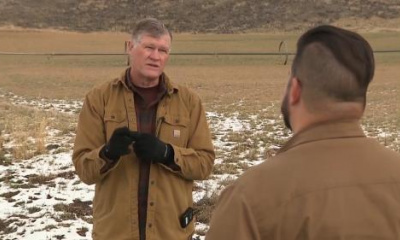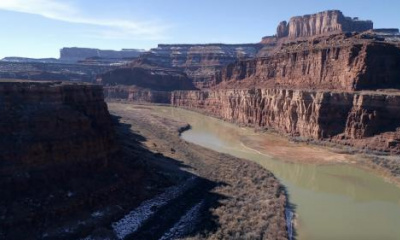As western states expand cash incentives to eliminate thirsty grass lawns and switch to drought-friendly gardens, homeowners are running into a snag:
- Many of the recommended native and desert-adapted plants are unavailable to buy.
Why it matters: Utah and other fast-growing western states have made re-landscaping a central water conservation policy amid decades of drought.
- Utah uses more residential water per capita than any state except Idaho — and most of it goes to lawns and gardens.
- Explosive growth in the West is driving water consumption, and demand could increase exponentially if developers turn to conventional lawns rather than drought-friendly landscaping.
State of play: Nursery operators and landscapers tell Axios they're scrambling to get plants that are recommended for sustainable curb appeal in the high desert — even longtime favorites like native penstemons, Rabbitbrush and Mohave Sage.
- "Demand has just soared, so I can book [an order] out a year ahead of time — but I'm not guaranteed to get it," said Brad Christensen, horticulture director for Salt Lake's Deseret Nursery.
Zoom out: Competition for drought-suited plants is heating up regionally, Christensen told Axios.
- One supplier told him Colorado nurseries offered to "buy all they could grow," he recounted. "They can't get [the plants] either, so we're in a fight for it."
- "We're actually not able to find anything in the southwest Utah market," added Todd Briggs, a Phoenix-based landscape architect who's working with a commercial client in St. George. "It's proven to be a serious challenge."
What they're doing: Nurseries, landscapers and homeowners are taking exhaustive measures to acquire the plants.
- To buy juniper and pinyon trees for her Orem home, gardener Emily Coleman flew to Denver and rented a truck to haul plants back from a nursery in Fort Collins.
- Christensen said he sends chocolates to growers so they'll remember him when they're inundated with orders.
- Colorado-based designer Lauren Springer told Axios she began growing herself; about half the community botanical garden she designed in Fort Collins was self-grown.
Zoom in: When recommended plants become available, they get snapped up immediately, Christensen said.
- Last August, he sold hundreds of Sundancer Daisies on one Saturday after word of the shipment got out on Facebook.
Big box chains generally don't sell many native or drought-adapted plants — though their suppliers have inquired about how to stock "more regionally appropriate plants," said Cynthia Bee, spokeswoman for the Jordan Valley Water Conservancy District.
Meanwhile, some of the region's major vendors are downsizing or closing right as demand skyrockets.
- "Local nurseries tend to have more expertise, but if you look at Salt Lake County, we've lost most of our nurseries to development," Bee told Axios.
- The same fate befell a Colorado grower that used to supply Deseret Nursery, Christensen said. A large, state-run nursery at Utah's former prison reduced operations in recent years, he added, and a seller in Fillmore is retiring.
- A major native trees supplier in Phoenix also closed this year Briggs said, and one of the largest wholesale growers in the southwest has shut its main location. "That is going to leave a huge void in the market," Briggs said.
The big picture: Xeriscaping is a relatively new development in the nearly-4,000-year history of gardening.
- The traditional landscapes of Europe and its former colonies — think grass lawns bordered by roses and lilies — come from design principles that often conveyed status, mastery or conquest.
- In the western United States, lush lawns and conventional gardens expressed settlers' belief in manifest destiny, said Ryan White, garden director for Washington County's water conservancy. They saw the land as theirs to "tame."
Between the lines: While growers have known how to handle many conventional garden plants for centuries, xeric plant production "is still a young science," Springer said.
- It takes a lot of experimentation to determine how easily a plant can be propagated, whether it's likely to survive the transplant, and how it responds to different garden conditions.
Those uncertainties mean growers are reluctant to attempt xeric plants even if they seem promising, Christensen said. He pointed to the Plant Select program at Colorado State University, which has identified and promoted nearly 200 attractive plants for dry western gardens.
- "They say, 'Hey, buy this one,' … but nobody produces starts of it," he said.
- As of this week, two of Utah's most extensive nurseries listed just three Plant Select products that are available.
Desert plants already "are much harder to produce under nursery conditions," Springer said.
- They need different soil types and watering schedules than most conventional garden plants, meaning automated greenhouse systems don't work well and operators are likely to see crop failures.
Details: The geraniums and petunias seen at big box garden centers typically are propagated in large farms in Central America, Christensen.
- Neither they nor wholesalers and retail nurseries are set up to drastically change growing conditions — especially when the western market is still eclipsed by the eastern population centers they already serve.
Of note: Desert plants also grow slowly, which means trees and shrubs could need years of care before they're ready to sell, said Doug Bennett, director of the Washington County water conservancy district.
- That means more overhead and expense for growers — and five to seven years lag to respond to customer requests.
Separately, the limited supply of plants means the push to re-landscape isn't creating the ecological diversity that replacing grass was supposed to accomplish.
- In Las Vegas — widely considered the gold standard for water conservation — just 20 plants account for about 90% of the plant cover, said Bennett who previously served as the water conservation manager over southwest Nevada.
- "We're essentially creating monocultures," White said. "That, in the long run, is going to create some bigger challenges when some [illness] sweeps through."
Threat level: Briggs said the thin plant supply could jeopardize efforts to incentivize re-landscaping.
- "My fear is we're going to shift away from this and go back to imported non-natives that use more water," he said.








